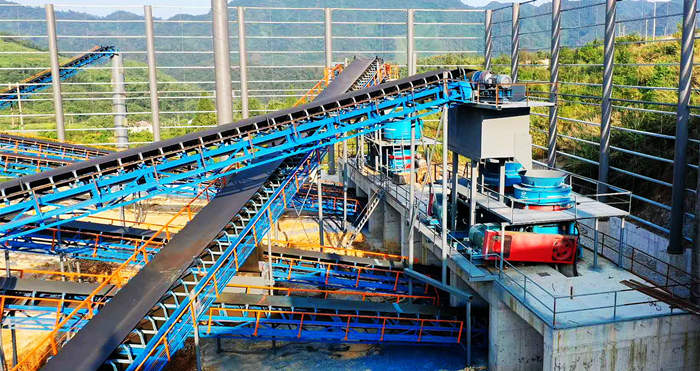Product Knowledge
The Process and Economic Considerations of Quartz Sand Crushing Plant
author:dahua2 time:2025-03-05
Quartz is one of the most abundant minerals on Earth. It ranks a seven out of 10 on the Mohs scale, which determines the hardness of a mineral, which means that it can be very difficult to crush.
Quartz is found in various geological environments, including igneous, metamorphic, and sedimentary rocks. Major sources of quartz include:
▪ Granite: A common source of quartz, often mined for construction and decorative stone.
▪ Sandstone: Composed largely of quartz grains, sandstone is processed into quartz sand.
▪ Vein Quartz: Found in hydrothermal veins, this form of quartz is often high in purity and used in specialized applications.
Quartz is crushed in order to separate out gold deposits often found inside. The crushed mineral can also be used for other industrial refining applications.
The Process of Quartz Sand Crushing Plant
Quartz is a relatively hard mineral. The crushing can be processed in three steps to reduce the quartz material into small particle size for final application or further processing: primary crushing, secondary crushing and tertiary crushing.
The feeder or screens separate large boulders from finer rocks that do not require primary crushing, thus reducing the load to the primary crusher. The stone that is too large to pass through the top deck of the scalping screen is processed in the secondary crusher. Tertiary crushing is usually performed using cone crushers or other types of impact crushers.
1. Primary Crushing
The first step in quartz processing is primary crushing, which involves breaking down large quartz rocks into smaller pieces. This is typically achieved using:
Jaw Crushers: These machines crush the quartz by applying compressive force. The material is fed into the jaw chamber, where it is crushed between a fixed and a moving jaw.
2. Secondary Crushing
After primary crushing, the material undergoes secondary crushing to achieve finer particle sizes. This stage may involve:
Cone Crushers: These crushers use a rotating cone to crush the quartz further. They are particularly effective for producing uniform particle sizes and are suitable for hard materials.
3. Tertiary Crushing
For applications that require very fine quartz particles, tertiary crushing may be necessary. This can involve:
Impact Crushers: These machines utilize impact forces to break down materials. They are effective for producing fine aggregates and are often used in the final stage of crushing.
4. Screening
Once the quartz has been crushed to the desired size, it is screened to separate fine particles from larger ones. Screening equipment includes:
Vibrating Screens: These screens use vibration to separate particles based on size. They are essential for ensuring that only the desired particle size is sent for further processing.
5. Washing Plant
Washing is often necessary to remove impurities from quartz sand. Equipment includes:
Sand Washers: These machines wash away clay, silt, and other impurities, ensuring the purity of the final product.
Hydrocyclones: Used for separating fine particles from the washing process, hydrocyclones are effective in improving the quality of quartz sand.
Best Practices for Quartz Crushing Processing Plant
To optimize the performance of quartz crushing plant, several best practices should be followed:
1. Process Optimization
Regular Maintenance: Implement a routine maintenance schedule for all equipment to minimize downtime and ensure efficient operation.
Performance Monitoring: Use monitoring systems to track the performance of crushers and screens, enabling timely adjustments to improve efficiency.
2. Material Handling
Proper Feeding Techniques: Ensure that materials are fed into crushers at the correct rate to prevent blockages and maintain optimal crushing performance.
Stockpile Management: Efficiently manage stockpiles to ensure a consistent supply of raw materials for processing.
3. Environmental Considerations
Dust Control: Implement dust suppression systems to minimize airborne particles during crushing and screening.
Water Management: Utilize water recycling systems to reduce water consumption and manage wastewater effectively.
4. Safety Measures
Training Programs: Provide comprehensive training for operators on equipment handling, safety protocols, and emergency procedures.
Personal Protective Equipment (PPE): Ensure that all personnel are equipped with appropriate PPE, including helmets, gloves, and respiratory protection.
Economic Considerations
Cost Analysis
A thorough cost analysis is essential for evaluating the feasibility of a quartz crushing processing plant. Considerations include:
▪ Capital Investment: Assess the initial costs associated with purchasing equipment and setting up the plant.
▪ Operating Costs: Calculate ongoing expenses, including labor, maintenance, and utilities.
Return on Investment (ROI)
Evaluate the potential ROI by analyzing production capacity, market demand, and selling prices for processed quartz products. A well-planned operation can lead to significant profits over time.
Quartz crushing plants are an essential component of producing high-quality quartz products. By understanding the characteristics of quartz, optimizing the crushing process, selecting the right equipment, and following best practices, operators can ensure the efficiency and effectiveness of the plant. As market demands evolve, staying up to date on industry trends and advancements will position quartz processors for long-term success in a competitive environment. By embracing innovation and sustainability, quartz crushing plants can meet the growing demands of various industries while minimizing the impact on the environment.
Previous Article:No Information
Next Article: What is the Price of Mobile Sand Making Machines?







